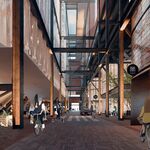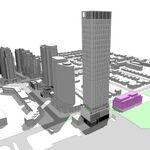If you read through the French language media and commentary, majority of objections to building on an elevated structure on RL Boulevard are from urban planners and engineers, and not due to environmental or historical preservations (we aren't even in BAPE yet) or simple suburban NIMBYism. It's purely the logistics and integration of a large elevated infrastructure (and much larger station footprint) within 30-35 m road clearance, in the middle of a high rise canyon on both sides of the boulevard. I know people like to compare it to Vancouver Skytrain / Canada Line, but there are 2 key differences:
1. Most Vancouver neighborhoods outside of downtown have much lower density (both structural and population) than Montreal, not to mention downtown Montreal / Rene-Levesque Boulevard which is home to some of the densest and tallest commercial and residential neighborhoods in Canada. Cambie for the most part was and still is predominantly suburban single family home with a very wide road clearance. Richmond No. 3 road was even less dense when Canada Line was proposed. Canada Line ended up being buried under Cambie because of NIMBYism from some of the wealthiest residents in Vancouver who live along Cambie.
2. Speaking of Expo and Canada Line - both lines went underground as soon as they entered downtown (with the exception of Chinatown station on Expo). Imagine now that Translink is proposing an elevated Skytrain down Burrard or Granville streets in downtown Vancouver, cutting up downtown Van in half and mere meters away from historic structures like the Fairmont or the billion-dollar commercial high rises like the Bentall Centre. I'm absolutely certain the whole city of Vancouver would rise up.
This is a quick rendering of the elevated REM-B on the current Rene-Levesque boulevard done by a local engineer (important to consider the impact not only of the rail lines but the large station footprint and how they impact surrounding high rises):
View attachment 292522
Current RL Boulevard - notice the high building canyon and the distance between the tight clearance in between building facades.
View attachment 292523
View attachment 292527





